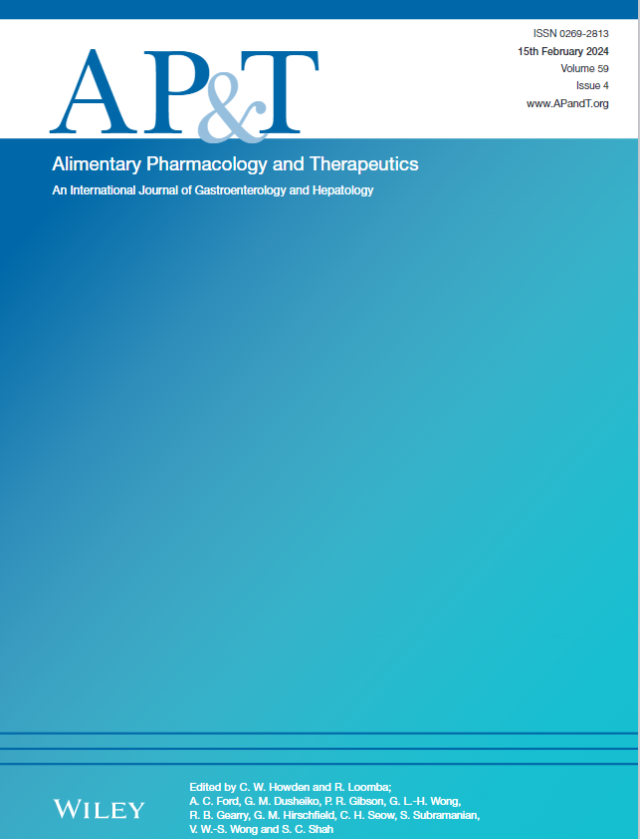Exploration of Multiple Non-Invasive Tests for Assessing Response to Treatment in a Semaglutide Phase 2b Trial in Patients With MASH.
IF 6.7
1区 医学
Q1 GASTROENTEROLOGY & HEPATOLOGY
引用次数: 0
Abstract
BACKGROUND Non-invasive tests (NITs) are not currently approved as biomarkers of treatment response for patients with metabolic dysfunction-associated steatohepatitis (MASH). AIM This retrospective study explored a panel of NITs for assessing response to semaglutide treatment in patients with MASH randomised in a phase 2b trial (NCT02970942). METHODS The present study was performed using the completer population (268 patients), defined as all patients who were randomised, remained on treatment throughout the trial, and had liver biopsy and NIT results at baseline and week 72. Semaglutide treatment arms were analysed as one semaglutide pooled group. Multiple NITs (alanine transaminase, aspartate transaminase [AST], controlled attenuation parameter, CK18-M30/M65, SomaSignal nonalcoholic steatohepatitis tests, FibroScan-AST, NIS-4, metabolomics advanced steatohepatitis fibrosis score, fibrosis-4 index, liver stiffness measure [LSM], enhanced liver fibrosis [ELF], PRO-C3 and ADAPT) were assessed. Treatment response was evaluated by NITs using either mean changes, responder groups, or risk categories from baseline to week 72. RESULTS Semaglutide treatment led to significant reductions versus placebo in all NIT scores from as early as 28 weeks. More patients had MASH improvement and fewer had fibrosis progression versus placebo when assessed by a 20% NIT response (0.5 U for ELF); among patients with baseline LSM > 8 kPa and ELF > 9.8 U, a larger proportion achieved LSM < 8 kPa and ELF < 9.8 kPa with semaglutide versus placebo. CONCLUSION NITs may be used for assessing a treatment response in patients with MASH. Further studies should confirm the treatment effect of NITs and evaluate the association of NIT changes to outcomes.在一项Semaglutide 2b期临床试验中,探索多种非侵入性试验评估MASH患者对治疗的反应。
背景:非侵入性检测(NITs)目前尚未被批准作为代谢功能障碍相关脂肪性肝炎(MASH)患者治疗反应的生物标志物。这项回顾性研究探讨了一组nit,用于评估在2b期试验(NCT02970942)中随机分配的MASH患者对西马鲁肽治疗的反应。方法:本研究采用完整人群(268例患者)进行,定义为所有随机分组的患者,在整个试验期间保持治疗,并在基线和第72周进行肝活检和NIT结果。Semaglutide治疗组作为一个Semaglutide合并组进行分析。评估多项nit(谷丙转氨酶、天冬氨酸转氨酶[AST]、控制衰减参数、CK18-M30/M65、somassignal非酒精性脂肪性肝炎试验、FibroScan-AST、NIS-4、代谢组学晚期脂肪性肝炎纤维化评分、纤维化-4指数、肝刚度测量[LSM]、肝纤维化增强[ELF]、PRO-C3和ADAPT)。从基线到第72周,通过NITs使用平均变化、应答者组或风险分类来评估治疗反应。结果早在28周时,与安慰剂相比,semaglutide治疗导致所有NIT评分显著降低。当以20%的NIT反应(ELF为0.5 U)评估时,与安慰剂相比,更多的患者有MASH改善,更少的患者有纤维化进展;在基线LSM >为8 kPa,基线ELF >为9.8 U的患者中,与安慰剂相比,西马鲁肽达到LSM < 8 kPa和ELF < 9.8 kPa的比例更大。结论nits可用于评估MASH患者的治疗反应。进一步的研究应证实NIT的治疗效果,并评估NIT变化与预后的关系。
本文章由计算机程序翻译,如有差异,请以英文原文为准。
求助全文
约1分钟内获得全文
求助全文
来源期刊
CiteScore
15.60
自引率
7.90%
发文量
527
审稿时长
3-6 weeks
期刊介绍:
Alimentary Pharmacology & Therapeutics is a global pharmacology journal focused on the impact of drugs on the human gastrointestinal and hepato-biliary systems. It covers a diverse range of topics, often with immediate clinical relevance to its readership.

 求助内容:
求助内容: 应助结果提醒方式:
应助结果提醒方式:


